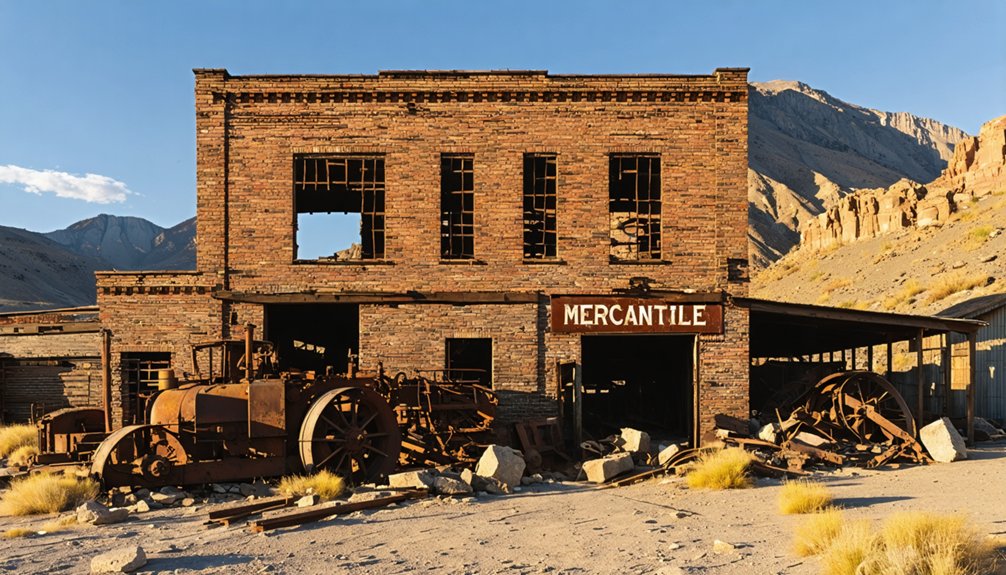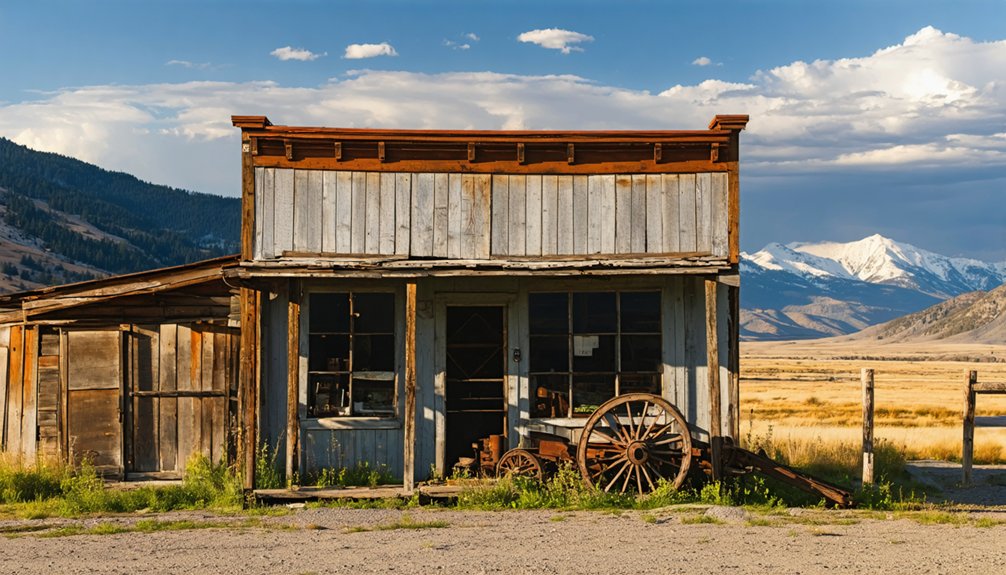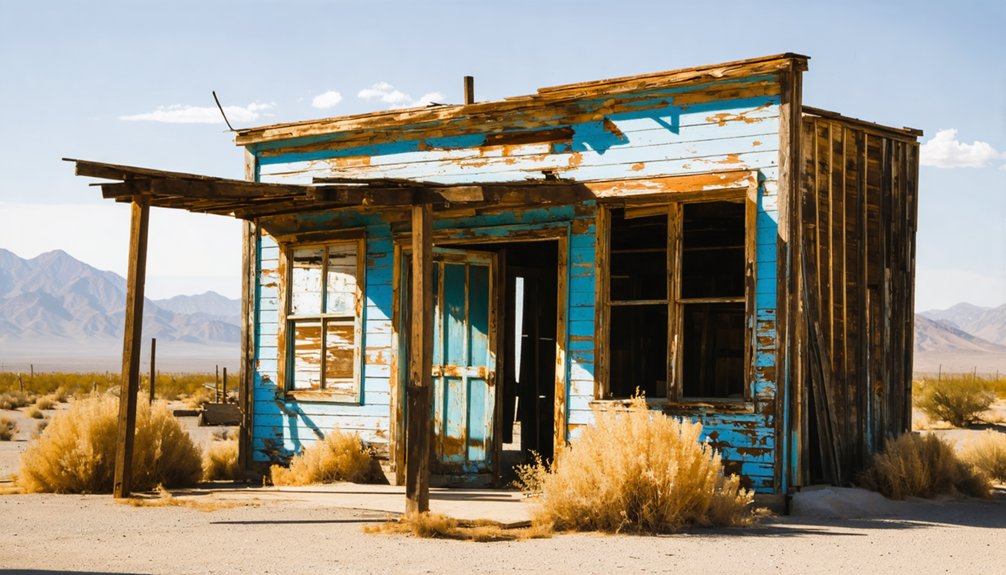You’ll discover Bellevue’s dramatic transformation from an 1880s silver mining boomtown of nearly 900 residents to a near ghost town by 1900. After silver’s discovery in Idaho’s Wood River Valley, the town flourished with 20-30 productive mines, including the famous Triumph Gulch operation. The 1888 International Silver Depression, coupled with ore depletion and an 1905 fire, decimated the population. While Bellevue avoided complete abandonment, its 24 preserved 1880s buildings tell a compelling story of boom, bust, and survival.
Key Takeaways
- Bellevue declined from a bustling mining town of 892 people in 1890 to just 356 by 1900 following silver market crashes.
- A devastating fire in 1905 destroyed Bellevue’s business district, accelerating its transition from mining hub to small agricultural community.
- The loss of county seat status to Hailey in 1895 and unfavorable railroad placement shifted economic power away from Bellevue.
- Twenty-four original buildings from the 1880s remain preserved in the Bellevue Historic District, including the Historic Town Hall and Jail.
- While Bellevue experienced significant decline, it avoided complete abandonment by transitioning to agriculture rather than becoming a true ghost town.
The Birth of a Silver Mining Hub
When silver was discovered in Idaho’s Wood River Valley in 1880, it sparked an immediate mining rush that transformed the region.
You’ll find that 20-30 mines quickly sprang up, including the legendary Triumph, Independence, and North Star operations, each tapping into rich ore veins that promised fortune and freedom.
The shift from gold-silver to lead-silver ores revolutionized mining techniques in the valley. The mine at Triumph Gulch became especially significant, producing over 20 million in minerals.
The discovery of lead-silver deposits transformed local mining practices, ushering in new methods and technologies across Wood River Valley.
While early processing challenges initially hindered progress, the establishment of local smelters in Hailey (1881) and Ketchum showed remarkable community resilience.
You can trace Bellevue’s roots to this pivotal moment, as the town emerged alongside its neighbors to support the booming industry.
The proximity to valuable mineral deposits turned what was once frontier wilderness into a bustling hub of mining activity and economic opportunity.
The arrival of the railroad in 1883 accelerated the region’s growth by providing crucial transportation infrastructure.
Historic Architecture Along Oak Street
Along Oak Street in Bellevue, you’ll discover a remarkable collection of Late Victorian architecture dating back to 1880, with buildings that showcase intricate galvanized sheet iron facades and detailed wood ornamentation.
The architectural significance of this historic district, recognized on the National Register since 1982, tells the story of a once-thriving mining town through its preserved commercial and residential structures. Among these historic buildings, the Idaho State Bank building, established in 1910, recently underwent extensive renovations after being purchased in 2016. The town grew rapidly after the discovery of the Queen of the Hills mine nearby in July 1879.
When exploring Oak Street’s historical preservation efforts, you’ll find:
- The iconic I.O.O.F. Hall, built in two stages (1884 & ~1900), featuring an iron facade from St. Louis
- The N.C. Larsen House, displaying late Italianate style wood ornamentation and bracketed windows
- Twenty-four contributing buildings within the 10-acre district, bounded by U.S. 93, Cedar, 4th, and Oak Streets
Mining Boom and Geological Challenges
The architectural grandeur of Oak Street stands as a tribute to Bellevue’s prosperous silver mining era that began in the early 1880s.
Oak Street’s majestic buildings echo the wealth and ambition of Bellevue’s silver mining glory days in the 1880s.
You’ll find that between 1880 and 1890, about 20 to 30 mines flourished in the region, with geological surveys revealing rich but irregular silver veins that challenged even the most advanced mining techniques of the time.
While the arrival of the Oregon Short Line Railroad in 1883 spurred industrial-scale operations, the mines’ success was short-lived.
By the late 1880s, you’d have witnessed the devastating impact of plummeting silver prices and depleting ore quality. The mines couldn’t sustain their yields, and by 1893, most operations had shuttered.
Like the nearby town of Eagle Rock, Bellevue struggled to maintain its economic stability through mining challenges.
Despite attempts to extend mining activities and infrastructure improvements like the Bellevue Water Works, the boom couldn’t overcome the harsh realities of geological limits and market forces. The International Silver Depression of 1888-1898 dealt the final blow to mining operations, leading to widespread abandonment of the area.
From County Seat to Ghost Town Status
Despite its earlier mining prosperity, Bellevue’s role as Logan County’s seat from 1889 to 1895 marked a brief period of administrative prominence before its eventual decline.
The town’s political decline accelerated when Logan County dissolved, and Hailey claimed the county seat of newly formed Blaine County in 1895.
Three critical events sealed Bellevue’s fate:
- The railroad’s strategic placement through Hailey shifted economic power away.
- A devastating 1905 fire destroyed the business district, crippling commerce.
- The silver crash and mining bust drove population toward other regional centers.
You’ll find that Bellevue’s transformation from a bustling hub of 10,000 residents to a near-ghost town reflects the harsh realities of frontier boom-and-bust cycles, where political power and economic prosperity often proved fleeting.
Agricultural Legacy and Economic Shifts
You’ll find Bellevue’s agricultural success rooted in its mile-wide plateau, where rich soil proved ideal for fruit and vegetable cultivation.
While mining initially drove the town’s economy in the 1880s, the fertile land became increasingly essential as mineral extraction declined after 1900.
The Reclamation Act of 1902 transformed agricultural possibilities in the region through extensive irrigation projects.
The town’s agricultural foundation strengthened through the development of irrigation systems and expanded farming operations south of Bellevue, helping maintain its population even as other economic sectors struggled.
Fertile Plateau Supports Farming
During the late 1800s, fertile conditions and adequate moisture on the Columbia Plateau attracted pioneering farmers who recognized its potential for grain cultivation.
You’ll find that early settlers initially worked the land using basic tools like “foot burners” and cradle scythes before advancing to more efficient horse-powered machinery in the 1870s. The labor-intensive farming methods required 120 men and 320 animals for harvesting teams in the 1920s.
The region’s agricultural development transformed through:
- Advanced irrigation techniques in the 1960s that turned marginal lands into productive fields
- Implementation of crop rotation systems that enhanced soil fertility
- Introduction of center-pivot irrigation that revolutionized water distribution
This agricultural evolution considerably impacted the area’s economy, driving the growth of local towns and establishing essential processing facilities.
The Columbia Basin Project‘s goal to irrigate over a million acres further cemented the region’s farming legacy.
Rich Soil Drives Growth
The rich, fertile soil of Bellevue’s mile-wide plateau established the town’s agricultural foundation, particularly for fruit cultivation and livestock grazing.
You’ll find that early settlers implemented sustainable practices through strategic ditch digging and meadow drainage, transforming peat-heavy areas into productive farmland by 1906.
Community involvement flourished as farmers capitalized on the plateau’s natural drainage for orchards and hayfields. The demand for hay skyrocketed, especially from logging operations, with prices reaching $100 per ton.
You can trace how this agricultural shift helped stabilize Bellevue’s economy after mining’s decline, creating jobs in farming and orchard management.
The Oregon Short Line Railroad enhanced market access, while irrigation projects expanded arable land, cementing agriculture’s role in Bellevue’s development.
Transitioning From Mining Economy
While agriculture strengthened Bellevue’s foundation, a dramatic change in the town’s economic landscape began taking shape in the late 19th century.
The mining boom that once defined the region couldn’t sustain itself, leading to economic diversification and community resilience through:
- The shift from the Minnie Moore and Independence mines to agricultural development, utilizing the region’s fertile soil
- A population drop from 892 in 1890 to 356 by 1900, forcing adaptation to new economic realities
- Infrastructure improvements, including the 1887 Bellevue Water Company, which supported both farming and urban needs
You’ll find that as mining operations dwindled, the town’s economy evolved toward small businesses and community services, transforming from a bustling mining hub into a more stable, agriculture-based community.
Exploring Mining Ruins and Historic Sites

Mining enthusiasts exploring Bellevue’s historic sites will find a wealth of 19th-century ruins centered around the famous Minnie Moore Mine, located three miles west of town via Broadford Road.
While you’ll need permission to access the private property, the site’s historical significance is evident in the weathered wood buildings and grey mill tailings that remain.
Though privately owned today, these preserved buildings and scattered tailings whisper stories of Idaho’s silver mining heritage.
You can’t venture into the main shaft, which has been flooded since the 1950s, but the visible mining artifacts tell the story of silver extraction techniques that made this one of the region’s deepest and most productive mines.
The surrounding Bullion District showcases additional ruins from the era when mining titans like W. H. Broadhead and David Ketchum transformed this corner of the Wood River Valley into a bustling industrial center.
In the early days, miners transported over 600 tons of ore to Kelton before the railroad’s arrival made shipping more efficient.
Remember to respect historic sites by staying on established paths and never removing artifacts from the area.
Modern Growth in a Historic Setting
Beyond the remnants of Bellevue’s mining era lies a modern community that has skillfully preserved its historic character.
You’ll discover 24 original buildings from the 1880s, including the Bellevue State Bank, creating an authentic window into Idaho’s pioneering days.
- The town’s fertile plateau location, just 18 miles south of Sun Valley, positions it perfectly for sustainable growth while maintaining its historical integrity.
- The abandoned Oregon Short Line rail grade weaves through residential areas, reminding you of the town’s transportation heritage.
- Big Wood River’s proximity and mountain vistas offer both practical resources and scenic appeal for modern development.
Unlike many mining towns that faded into obscurity, Bellevue’s balanced approach to historical preservation and modern growth has created a thriving, independent community.
Preserving the Wood River Valley Heritage

As a tribute to Idaho’s pioneer heritage, the Bellevue Historic District preserves 24 original buildings from the 1880s that showcase the authentic character of a Wood River Valley mining community.
You’ll find rare examples of vernacular and folk architecture that have survived the test of time, including the historic Town Hall and Jail, now home to the Bellevue Historical Museum.
Heritage conservation efforts focus on maintaining these structures, some in good condition while others need restoration.
The district’s unique features include the Oregon Short Line’s abandoned tracks running through residential areas.
Through community engagement, the Bellevue Historical Society works to protect these landmarks while educating visitors about the town’s rich mining and agricultural past along the Wood River.
Frequently Asked Questions
What Native American Tribes Originally Inhabited the Bellevue Area?
You’ll find the Shoshone and Bannock tribes were the primary Native tribes of historical significance here, with the Tukudika (Sheep Eater) band of Shoshone specifically inhabiting the mountainous terrain.
Are There Any Haunted Buildings or Paranormal Activities Reported in Bellevue?
You won’t find documented ghost sightings within Bellevue’s historic buildings, though you’ll encounter the popular Bellevue Haunted Forest nearby and several reported haunted locations in surrounding southern Idaho towns.
What Was the Average Silver Miner’s Daily Wage in 1880S Bellevue?
You’ll find silver mining wages from 1880s Bellevue aren’t precisely documented, though miners in similar Western operations earned $2.50-$4.00 daily, depending on their skill level and market conditions.
Which Local Festivals or Annual Events Celebrate Bellevue’s Mining Heritage Today?
You won’t find festival highlights or mining reenactments celebrating Bellevue’s mining heritage today. Unlike other Idaho mining towns, Bellevue doesn’t currently host any annual events focused on its mining past.
How Did the Great Depression Specifically Impact Bellevue’s Mining Community?
You’ll find that the Great Depression devastated Bellevue’s mining community through mine closures, job losses, and population decline, forcing many miners to leave town while surviving operations struggled with reduced production.
References
- https://history.idaho.gov/wp-content/uploads/2018/09/Bellevue_Historic_District_82002506.pdf
- https://npshistory.com/publications/blm/historic-mines-blaine-co.pdf
- https://bellevueidaho.gov/about-bellevue/
- https://valleychamber.org/idaho-mines/
- https://www.ghosttowns.com/states/id/bellevue.html
- https://visitidaho.org/things-to-do/ghost-towns-mining-history/
- https://en.wikipedia.org/wiki/Bellevue
- https://comlib.org/2022/rear-view-mining-days-of-old/
- https://history.idaho.gov/wp-content/uploads/2018/12/0160.pdf
- https://eyeonsunvalley.com/kiosk/Kiosk_Story?StoryId=13212&ScreenName=



